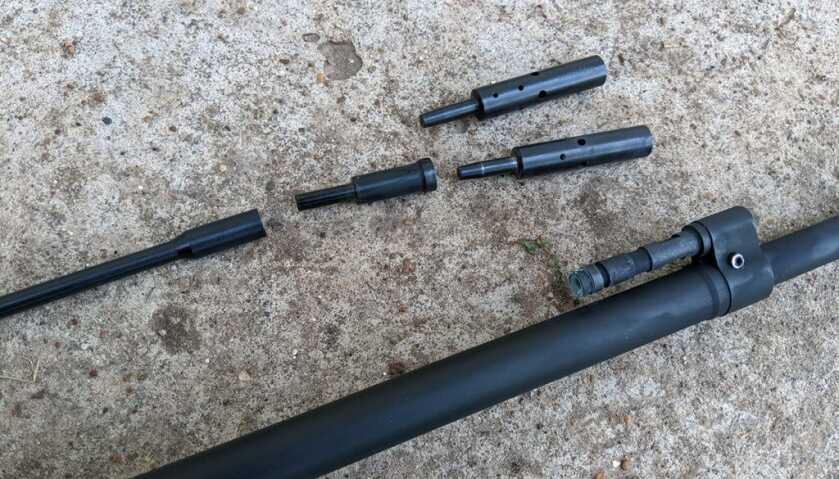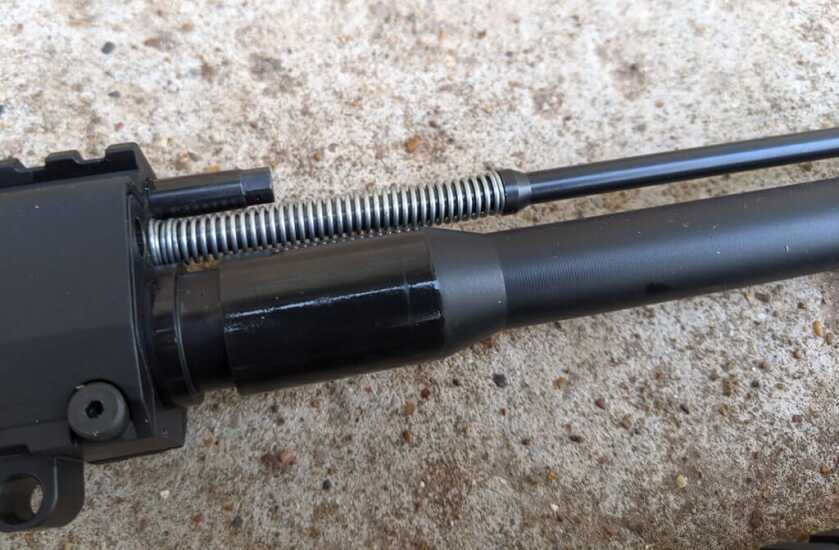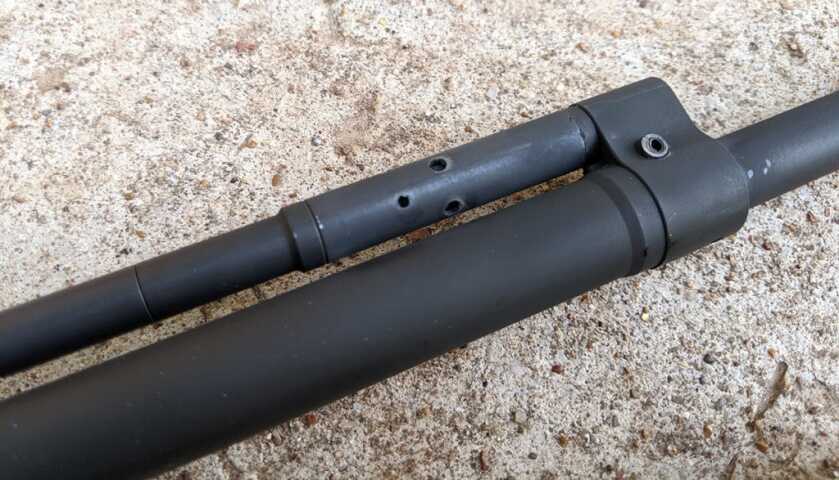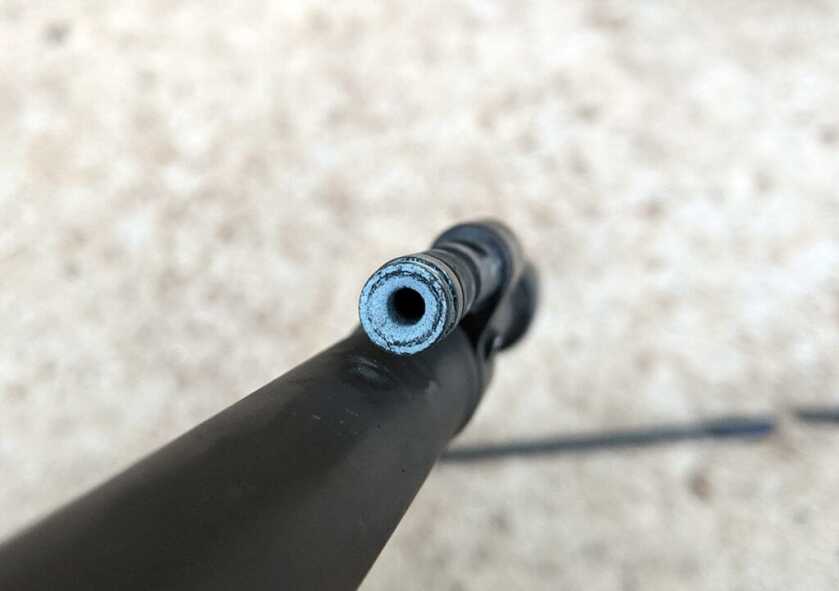
If the latest fashion trends are any indication, the maxim “everything old is new again” has never been truer, and the wonderful world of firearms is no exception.
Brownells recently released an entire stable of Retro Rifles spanning the last six decades, and the line’s success has uncovered a serious nostalgia for Vietnam-era firearms. Where our parents pined for the wood and steel of the M1 Garand, this generation looks back on the first polymer space guns and says, “Now those were the days…”
The BRN-180 was perhaps the most anticipated of Brownell’s old-school firearms. Based on the AR-18/AR-180 of the 1960s, the BRN-180 upper uses a self-contained recoil system that allows the action to cycle without a buffer spring (hello, folding stock!). The piston-operated design is ultra-reliable, and best of all, the unit will function on any mil-spec AR-15 lower receiver.
I’ve had a great time taking the BRN-180 for a spin. While its accuracy leaves something to be desired, it functioned flawlessly with a wide variety of .223/5.56 cartridges, and the action design allows for a super-compact defensive option.

Specifications
- BRN-180™ has 16″ barrel with matte black Nitride finish
- BRN-180S™ has 10.5″ barrel with matte black Nitride finish
- AR-180 piston operating system
- Compatible with current mil-spec AR-15 lowers
- Machined 7075 T6 aluminum receiver & handguard – hardcoat anodized finish
- .223 Wylde chamber
- Nickel-Teflon coated bolt
- Button rifled bore; 1-8″ twist
- 1/2″-28 threaded muzzle
- Replica 3-prong AR-180 flash suppressor
- Molded polymer ejection port cover
- MSRP: $799 – $827.99
The AR-18/AR-180: A Brief History
ArmaLite developed the AR-18/AR-180 in an ultimately unsuccessful attempt to correct one of the costliest mistakes in firearms manufacturing/R&D history.
According to an official document outlining the company’s tortured journey, ArmaLite began developing the AR-15 after a nearly successful attempt to convince the Army to adopt the AR-10. Military brass was curious about the AR-10’s space-age design, and they wanted to see a smaller caliber version. ArmaLite was happy to oblige, but the company was discouraged when international militaries passed on the AR-10, and executives had already decided to focus on the military rather than the commercial market. So, they licensed designs and trademarks of both the AR-10 and AR-15 to Colt in 1959.
Whoops.
Needless to say, ArmaLite regretted selling to its competitor what would become one of the most iconic rifles in world history. The AR-18 was the company’s attempt to break into the military market without violating the AR-15’s design.



“It was obvious from Army purchases of the AR-15 that Fairchild [ArmaLite’s parent company] had erred in selling the AR-15,” ArmaLite’s document explains. “To recover from that error, ArmaLite set about to develop a new rifle that wouldn’t violate the Stoner gas system patents, which now belonged to Colt. The result was the AR-18, which began development in 1963.”
The new .223 caliber rifle featured a stamped sheet metal receiver to reduce production costs and differed from the AR-15 in two primary ways. First, it used dual operating springs on rods in the receiver, which eliminated the need for a buffer spring and allowed it to use a folding stock. Second, it used a Tokarev-style sliding gas cylinder under the handguard to avoid violating the Stoner gas system that had been sold to Colt.
The company was hopeful its new rifle could replace the AR-15, but by that time Colt’s rifle was already too entrenched.
“The AR-18 was highly regarded, but didn’t find the favor that it could have,” the company says. “Even as ArmaLite marketed the new small-caliber rifle, FN and HK were selling more traditional 7.62mm rifles around the world. Colt was selling AR-15s. The AR-18 remained somewhat prone to breakage, and never enjoyed the success ArmaLite expected.”
Much more can be said about the history of this unique rifle, but here’s the bottom line: even though it had features to recommend it over the AR-15, the AR-18/180 was an unfortunate case of too little, too late for the AR’s namesake company.
Brownells’ Take on the Classic
Now Brownells has resurrected and popularized the quirky rifle, but they’ve made some changes. Brownells’ Director of Product Management Paul Levy told me via email that the upper was designed by Primary Weapons Systems and FM Products after he and his team told them they wanted to adapt the AR-18/180 upper to a standard AR-15 lower.



The engineers started with modernizing the handguard. On the original rifle, only the top portion of the handguard could be easily removed to access the gas system. On the BRN-180, the entire free float handguard can be removed from the front of the rifle, which allows the Standard Piston Cup to be swapped for the Suppressed Piston Cup (on the BRN-180S, the gas system is fully adjustable). Users simply field strip the rifle, pull down on the U-clip located near the front of the receiver, and slide off the handguard assembly.
Engineers also had to shorten the bolt carrier because the AR-15 lower has a shorter length of travel than the AR-180. Shortening and lightening the bolt carrier necessitated slight modifications to the gas and recoil system to guarantee reliability (which I found to be excellent – more on that below).
Otherwise, beyond the machined rather than stamped aluminum receiver, Brownells and their partner companies remained faithful to Eugene Stoner’s original design.
“We’re big fans of Eugene Stoner’s work,” Levy told me. “I had recently purchased an AR-180 and really appreciated how simple the operating system was. There have been adaptations of the AR-180 type gas system to the AR platform, but none had retained the recoil system in the upper. By keeping a good portion of the original design aesthetics, such as the charging handle and flash hider, we could also pay homage to that original configuration, and capture interest from those that wanted a reproduction AR-180.”
So, How’s It Shoot?
Every evaluation of a semi-automatic rifle comes down to two basic priorities: reliability and accuracy. I’ll start with reliability. The BRN-180 ran flawlessly even with the wide variety of ammunition I used during testing. I shot from the prone, kneeling, and standing positions; I shot off-hand, and I dumped a few mags with no malfunctions.

While Brownells didn’t reinvent the wheel with the BRN-180, they did adapt the original design for a standard AR-15 lower. The fact that the new system functioned so well testifies to the excellent R&D of Brownells and its partner companies as well as their quality control standards. If you (like me) hesitate to purchase “new” firearms until manufacturers work out the inevitable kinks, you can rest easy with the BRN-180.
Users can expect the upper to continue running, too. Unlike the direct gas systems used in most AR-15’s (more accurately called “internal piston systems”), the BRN-180 uses a gas piston operating system. The piston system replaces the hollow gas tube with a spring-loaded rod that moves back and forth and is powered by gas from the bore. Rather than feeding the gas into the bolt carrier group, the gas moves the piston, which in turn cycles the bolt.
In theory, the system is more reliable because it keeps the hot, carbon-filled gas out of the receiver. A cleaner receiver means fewer malfunctions, and a cooler receiver means fewer problems related to overheating.




In practice, the advantages are more difficult to determine. Mark Westrom, the Vice President for Business Development and Sales at ArmaLite’s parent company, Strategic Armory Corps, explained that junk (the technical term) from the bore still makes its way into the receiver via spent and extracted cases. Especially with a suppressor, gas and carbon travel both forwards and backward through the bore. Users should also be careful to clean the external piston and cylinder. Carbon buildup might not make it all the way to the receiver, but it does end up in the piston system.
Long story short: External piston operating systems like the one used on the BRN-180 might run somewhat cooler and cleaner than the more common AR-15, but they still need to be cleaned regularly.

Accuracy
The BRN-180 ran like a top, but the upper won’t be winning any long-range competitions. The BRN-180’s 4150 carbon steel barrel sports a .223 Wylde chamber with a 1:8” twist. Both the chambering and the twist rate allow the rifle to accommodate a wide variety of ammunition. A 1:8” twist rate can stabilize bullets between 55 and 77 grains, and the hybrid .223 Wylde chamber can (generally speaking) fire both .223 and 5.56 NATO cartridges safely and accurately.
That’s why I was surprised to learn that Brownells expects 1.5-2 MOA accuracy out of the BRN-180. I’ve owned and tested AR-15’s that shoot in the 1 MOA range and cost significantly less, and I know my experience isn’t uncommon. The BRN-180 has other good qualities that might justify the $800 price tag, but I wouldn’t call it a tack driver.

My testing confirmed Brownells’ expectations. Both the 55g Hornady and the 73g Federal match averaged 1.8 inches, with only one or two groups out of five exceeding two inches. The 75g American Eagle barely squeezed into the expected 1.5-2-inch range, and the other two groups shot well beyond it.
I shot all test groups from the prone position at 100 yards using a Caldwell Lead Sled. I used both a Vortex 3-9x and a Primary Arms 4-14x scope during testing, which had no effect on group size. The lower sported a Geissele Two-Stage Trigger.



I asked Westrom how the AR-180’s accuracy compared to the AR-15’s, and he gave the nod to the AR-15. While the average shooter might not notice a difference, the AR-180’s design reduces accuracy such that a target shooter would take note.
“[The piston system] has a spring that’s under compression. It’s trying to expand. As it does it’s spreading the top of the receiver and the barrel. It’s not detrimental to normal field accuracy, but it will make a difference for a target shooter,” Westrom said.
Brownells’ iteration maintains that good-but-not-great accuracy standard. The 55g Hornady will work for plinking, and the 73g Federal Match will hit targets out to extended ranges. But if you’re looking for your next long-range AR, the BRN-180 doesn’t – and wasn’t meant to – fill that void.
Final Shots
Accuracy aside, the BRN-180 is just plain cool. The side-charging handle is an attention-getter at the range, and the three-prong flash hider is a nice (historically accurate) touch. The BRN-180 pairs well with a folding stock, but the 10.5”-barreled BRN-180s would be even better. Since the action can cycle without the stock secured, the firearm could be deployed quickly in a self-defense situation, and the compact size makes it the perfect truck gun candidate.

With original AR-180’s pushing $2,000, the BRN-180 gives the average gun enthusiast a taste of history without breaking the bank. Brownells’ modern touches also mean that the rifle can function in almost any capacity you might use an AR-15, and its compatibility with Stoner’s original design allows users to pair the upper with their preferred trigger, pistol grip, and stock.
If you’re worried that ArmaLite’s quirky rifle is out of reach, check out Brownells’ new offering. The AR-180 never lived up to expectations, but the BRN-180 will live up to yours.

Disappointing accuracy, but I’m interested anyway, because I see the action as superior to the AR-15. I had a AR-180 and had fired the full auto legal versions, and mine took a real beating and was every bit as accurate as any AR I’ve fired! I regret trading it off – and only did so because I learned at the time that a new one was on the market – unfortunately the new AR-180 turned out to be a piece of junk, so I really messed up getting rid of my original. However at least I didn’t get hood winked into buying the newer product.
I am very interested in this upper, despite the price, and will hope I can finance it sometime in the future – if Brownelsl keeps it in stock that long!!
I’ve had an original AR180 for years and enjoy shooting it occasionally. I purchased a Brownell’s AR180 upper but have yet to find any AR15 lower that it will work with. Brownell’s support has been no help yet to solve the problem.
Hi Carl, that’s very strange. I put it on three different lowers with no trouble.
All that work, and they couldn’t put the charging handle on the left side where it belongs.
Myeh.
The charging handle is in its historically proper place. Moreover, its shape is historically accurate. The AR-180B, with its polymer lower receiver, had the placement correct, but ArmaLite used a “knob” style instead of the original “crank” style.
The AR-180B commercially failed because the part in the lower receiver where the upper receiver’s front pin went into had a propensity to break because the polymer was too thin. Even though this problem was a design defect, ArmaLite refused to fix the problem under warranty or issue a metal part to reinforce the weak joint. An aftermarket part was later sold, but the initial problem and lack of response by ArmaLite killed interest in the AR-180B.
“Historically” speaking, I could have many different guns that were of significant enough influence on the world.
The question is, is there a market? And THAT is a very big question in this area.
I predict this will be a dud.
Great review! I have been an AR-180 lover since I first laid eyes on one in 1976. It’s long, sleek, lower profile than the AR-15, gave it a very pleasing appearance. It always looked like a scaled down FAL to me.
Nice details on the Armalite Company and their heartache of selling off their golden goose before she started laying those golden eggs.
The Armalite AR-15 and AR-180 have lent their lineage to many other great rifles, but they are the originals. Glad to see Brownells lend a hand to the continuing story.
Thanks, Stevo.
Interesting, but I will pass. It doesn’t DO anything my A1 doesnt do better, and the upper cost more than my entire build. Cool factor is a harsh, and expensive mistress.
Your A1 huh? Dude stfu. This is a replica clone. Just stfu you dud mouth breathing old fart. Enjoy what Brownells has put out you cheap skate. Just because you think it’s expensive doesn’t mean we have to read your negative reply. Go dig a hole, kick rocks, do something other than post here you cheap sob
“The BRN-180 pairs well with a folding stock, but the 10.5”-barreled BRN-180s would be even better. Since the action can cycle without the stock secured, the firearm could be deployed quickly in a self-defense situation, and the compact size makes it the perfect truck gun candidate.”
While I would agree in principle, an important caveat would be to pair that 10.5″ BRN-180S upper with either a registered SBR lower(which I would rather not leave unattended in a truck/trunk), or a “pistol brace” on a non-registered lower, lest you fall afoul of the technicalities of the NFA…
Good point, Phil. As always, know/follow all applicable state and federal firearm laws that govern rifle barrels under 16″!
Why a non registered lower?
As it currently stands, the ATF doesn’t consider a firearm with a barrel less than 16″ a rifle if it has a pistol brace. So, if you have a pistol brace, you don’t need to register your lower as a short barreled rifle. That’s my understanding, at any rate.
I have an Olympic OA-96 which is a short barrel ar pistol, no stock or brace at all, nothing. Perfectly legal as long as you do not put a vertical grip on it.
And if you just omit the pistol brace, then there’s nothing resembling a stock for the BATF to say anything about. Almost exactly like a Kel-Tec PLR16, only more expensive and with a more storied pedigree.
The piston action is similar to the Ruger Mini14/30 bolt action. Only the piston is moving the bolt and not an external arm attached to the bolt on the side.